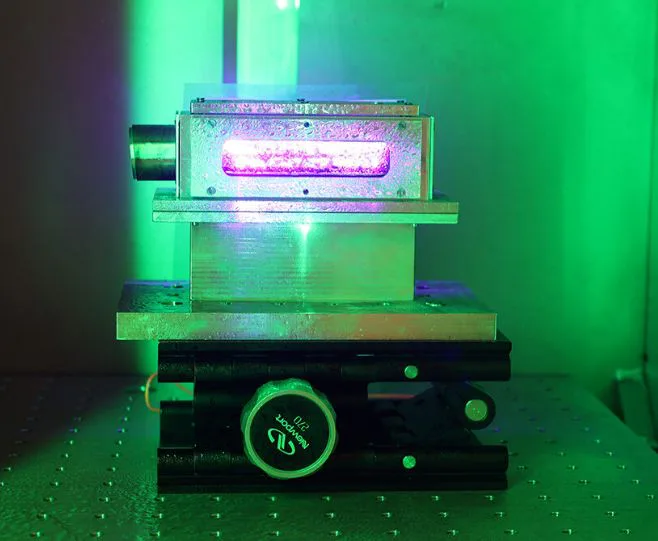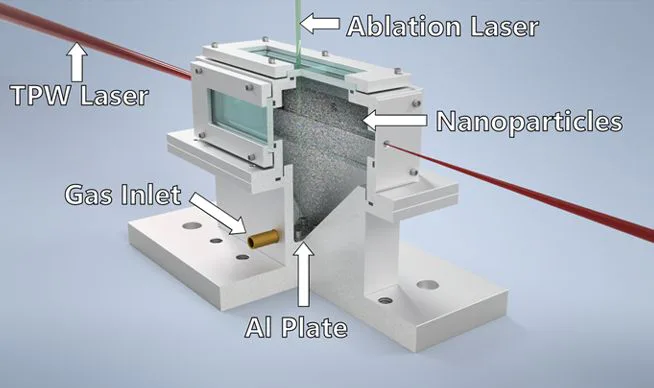
Particle accelerators are nothing less than super heroes! They rock the world of semiconductors, medical magic, and all kinds of cool research including materials, energy, medicine etc.
The only down side of this tech is, they require huge space, like kilometers of it. This makes them super pricey and time consuming of course.
To transcend these problems, researchers at The University of Texas at Austin and similar brains from national labs, European universities, and TAU Systems Inc., just pulled off something awesome.
They introduced this compact particle accelerator that’s less than 20 meters long. And at this length it packs a punch with a 10 billion electron volts (10 GeV) electron beam.
Although, there are already two other accelerators in the U.S. that can match that high electron energy. However, they’re like three kilometers long each.
The Advanced Wakefield Laser Accelerator
According to Bjorn “Manuel” Hegelich, the physics guru at UT and CEO of TAU Systems, their super cool advanced wakefield laser accelerator can hit those crazy energies in a space as small as 10 centimeters.
The team is currently exploring the use of their accelerator by checking the tolerance level with respect to radiation. And peeping into the 3D insides of new semiconductor chips. They also envision to develop novel cancer treatments and high resolutions of medical imaging tricks.

Microscopic Movie Camera for Super Tiny Action Scenes
Additionally, the advanced wakefield laser accelerator can power up X-ray free electron laser. In simple words, it can capture slow-motion movies of atomic or molecular-scale processes. It will be like microscopic movie camera for super tiny action scenes, such as:
- Drug interactions with cells: the movie on the molecular scale will show and help us understand how drugs play their roles in our cells.
- The nitty-gritty changes inside batteries: the technology will enable us to observe the intricate details of what happens within batteries at a tiny scale.
- Chemical reactions in solar panels: it’ll allow us to witness, in detail, the chemical processes happening within solar panels at a minuscule scale. It’s like having a zoom lens for the molecular dance that converts sunlight into energy.
- Viral proteins doing their thing when infecting cells: the tech will allow us to observe the undercover action of viral proteins changing shape when infecting cells.
From 1979’s Idea to Turbocharged Nanoparticle Surfing in Particle Accelerators
Back in 1979, the idea for wakefield laser accelerators was born. Picture this: a massive laser hits helium, transforms it into plasma, and those waves shoot out high-energy electrons.
Zoom ahead a few decades, and different research squads have upgraded the tech.
Now, Hegelich and his crew take it up a notch with nanoparticles. Another laser hits a metal plate, shoots metal nanoparticles into the gas cell, and boom! It’s like giving the accelerator a turbo boost with these tiny particles. Science with a dash of turbocharged coolness!
Imagine the laser as a boat gliding over a lake, creating a wake. Electrons ride this plasma wave like surfers catching a wave.
Think of nanoparticles as our electron-release Jet Skis, clarified Hegelich. They let electrons out exactly when and where we want, all lined up in the wave. Instead of electrons scattered randomly, we focus a bunch right where and when we need them. It’s all about precision!

Harnessing Texas Petawatt Laser for Compact System Development
For the study, the researchers used the Texas Petawatt Laser, one of the world’s most powerful pulsed lasers, located at UT. It shoots an ultra-intense light pulse every hour.
A single petawatt laser pulse packs about 1,000 times the electrical power but it only lasts 150 femtoseconds. Which is way shorter than a lightning discharge.
The team aims to make their system more practical by using a tabletop-sized laser. As of now, in the developmental stage, the device is capable of firing repeatedly at thousands of times per second. This would make the whole accelerator more compact and applicable in a broader range of settings than traditional accelerators.
Takeaway
The future of wakefield laser accelerators is looking seriously promising. They’re stepping up their game with advancements that scream precision, efficiency, and wider usability.
More breakthroughs are waiting to happen in all sorts of scientific and practical areas. We’re talking about a journey that kicked off back in ’79, and now we’re diving into the nitty-gritty with nanoparticles and ultra-intense lasers. It’s like the tech has this evolving potential that’s just waiting to blow our minds with exciting possibilities. Buckle up, because the ride ahead looks like it’s going to be one heck of a scientific adventure!



